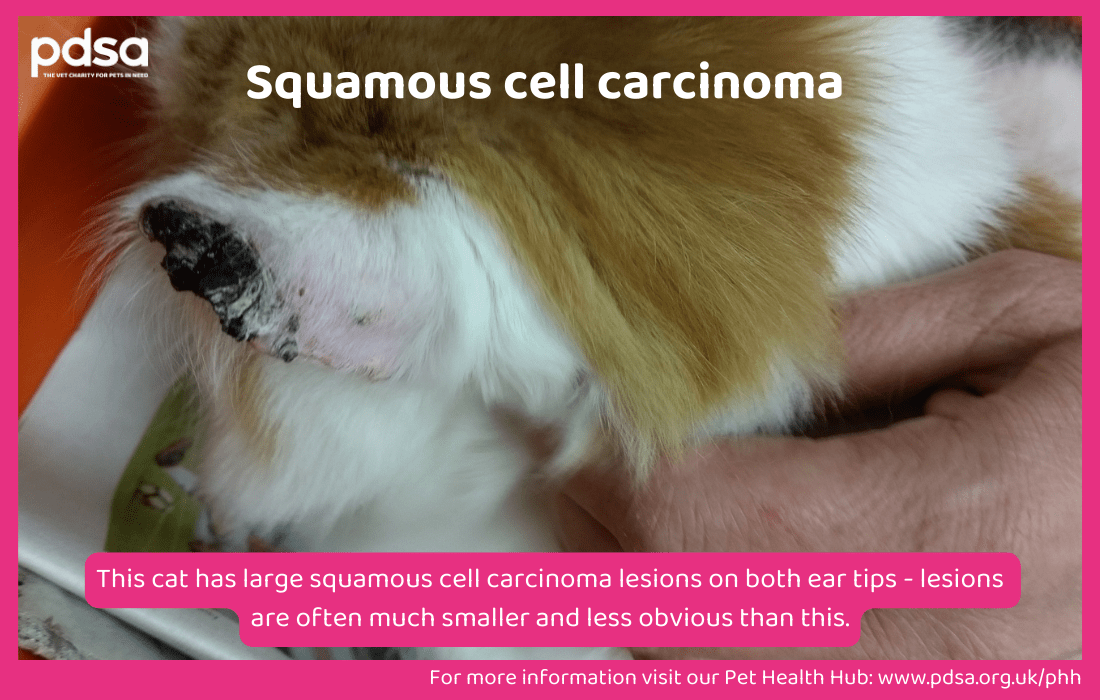Skin cancer in cats
Overview
- Skin cancer is an abnormal growth of cells in the skin.
- There are many different types of skin cancers in cats – some of the most common include squamous cell carcinomas (SCC), mast cell tumours, and fibrosarcomas.
- The most common signs of skin cancer include lumps, non-healing wounds, black crusty patches of skin (especially on the ear tips, nose and eyelids), and/or red raised areas of skin.
- There are a few different treatments for skin cancer in cats, depending on the type, size and location.
- Regularly check your cat for changes to their skin and book an appointment with your vet if you are worried.
Squamous cell carcinoma (SCC)
- SCC is a skin cancer caused by sunlight (UV) damage. It’s most likely to develop in hairless areas such as the ear tips, nose, and eyelids. White cats, cats with no fur, and cats with light-coloured skin are most at risk.
- SCC tends to initially appear as small areas of scabby, black crusty skin. These can then turn into red, raised, weepy areas of skin that don’t heal and become ulcerated.
- SCC can affect more than one area (for example ears and nose) – nearly half of cats diagnosed with SCC have more than one cancer lesion – look carefully for others. Fortunately, it’s usually slow to spread around the rest of the body.
- Patches of SCC tend to get worse in the summer and improve in the winter.
- Prevention is better than cure – protect your cat’s exposed skin and reduce the risk of SCC by applying a pet-safe, waterproof sunblock (factor 30 or above) every day. Alternatively, protect your cat from intense sunlight by keeping them inside on hot sunny days (especially around the middle of the day). Read more on how to put sunscreen on your cat.

Mast cell tumours
- Mast cell tumours on the skin don’t always look the same but they are usually a single, slow growing lump. You may notice red, itchy, hairless or ulcerated skin associated with the lump.
- They usually don’t spread to the rest of the body, but unfortunately some can.
- They are most commonly found on the head and neck.
- Some types of mast cell tumours can shrink and disappear completely but this is not common.
- They can also occur in the spleen and intestines.
Fibrosarcomas
- Fibrosarcomas are a type of skin tumour that can be found anywhere on the body but are most common on the head and legs.
- They tend to grow slowly and are slow to spread to the rest of the body but, eventually become very large and sometimes ulcerated.
- They are usually found in older cats.
- Feline Injection-site sarcomas (FISS) are a type of fibrosarcoma that can form after a cat has had an injection under the skin. This particular type of lump can grow more quickly.
Diagnosis
Your vet is unlikely to be able to tell you what type of skin cancer your cat has just by looking at it so, unless it’s obvious, they may suggest some tests to get a diagnosis. This may involve taking a tiny sample of the area with a needle and syringe (a fine needle aspirate), a slightly larger sample under anaesthetic (a surgical biopsy), or removing it completely. Some tests can be run ‘in-house’ (at your vet practice), while others will need to be sent to a special laboratory.
Sometimes, it’s necessary to check if the cancer has spread to the rest of the body which is likely to involve X-rays, ultrasound or more specialist imaging like a CT scan.
Treatment
Your cat’s treatment will depend on where their cancer is, how big it is, and whether it has spread around the body. Treatment is always easier if the cancer is small, caught early, and hasn’t spread. For all types of skin cancer, surgical removal may be possible if your cat’s cancer is small and in a location that is easy to operate on. If your cat’s cancer is large, or in an area difficult to operate on, removal may not be an option. There are specific types of treatment with each cancer:
SCC – If your cat has SCC on their ear tip(s), your vet may recommend removing part, or all of their ear – this operation is called a pinnectomy. The idea of removing the ears can take some getting used to, but it can cure the problem if the ears are the only area affected – and they won’t lose their hearing. Tumours on the nose and eyelids are usually more difficult to surgically remove than tumours on the ears. Small tumours (less than 1cm) on the nose and eyes can sometimes be removed with cryotherapy (extreme cold to freeze cancerous tissue), but if the cancer is larger than this, cryotherapy tends not to be effective.
There isn’t a medicine that specifically treats SCC, but to help with symptoms, your vet may decide to prescribe pain relief such as anti-inflammatory medicine.
Your vet may decide to refer your cat to a cancer specialist if their cancer is large or in an area that is difficult to treat. A specialist vet may decide to use other techniques such as radiotherapy.
Mast Cell tumour – Treatment for your cat’s mast cell tumour will depend on the size, location and whether it has spread or not. Treatment options may include surgical removal, chemotherapy and radiotherapy.
Fibrosarcoma – Treatment of a fibrosarcoma in your cat also depends on its location and size. Your vet may offer surgical removal. Radiotherapy or chemotherapy may be advised in some cases, but this usually requires referral to a cancer specialist. If the tumour is on your cat’s leg, amputation of the leg can also sometimes be advised as a treatment option.

Outlook
The outlook for a cat with skin cancer depends on what type they have, how quickly it is caught, and whether it’s spread anywhere else. In cases where the cancer is caught early, hasn’t spread, and can be completely removed, a full recovery is possible. Unfortunately, in other cases, the cancer will regrow if it can’t be removed completely.
If the cancer has already spread, or it can’t be removed, your vet may discuss a palliative care plan with you to ensure your cat is kept comfortable. This usually includes pain relief, anti-inflammatories, and regular check-ups to ensure they still have a good quality of life. If your cat is receiving palliative care but they seem to be getting worse or you’re worried they’re suffering, it may be kindest to consider putting them to sleep.
Cost
Treatment for skin cancer can become very expensive, so it’s important to speak openly with your vet about the cost of treatment, your finances, and what you think is right for your cat. There is sometimes more than one treatment option, so if one doesn’t work for you/your pet then your vet may be able to offer another.
Consider insuring your cat as soon as you get them, before any signs of illness start to ensure you have financial support to care for them.
Published: September 2023
Did you find this page useful?
Tell us more
Please note, our vets and nurses are unable to respond to questions via this form. If you are concerned about your pet’s health, please contact your vet directly.
Thank you for your feedback
Want to hear more about PDSA and get pet care tips from our vet experts?
Sign up to our e-newsletter
Written by vets and vet nurses. This advice is for UK pets only. Illustrations by Samantha Elmhurst.

